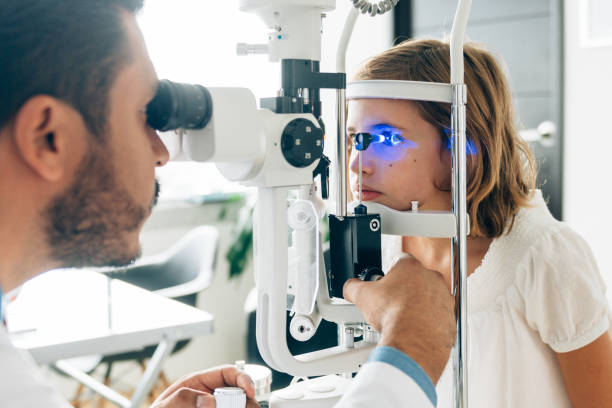Does Myopia have a cure?
Is it possible to restore your distance vision?
The prevalence of myopia, also known as nearsightedness, has been increasing and it is one of the most common refractive errors in both children and adults.
A recent study conducted by the American Optometric Association concluded that over 40 percent of Americans are myopic and that number is on the rise, especially among children in school. Myopia is considered a global epidemic. An estimated 75% of children diagnosed between the ages of 3 and 12 are diagnosed with myopia and 1 in 4 parents have children with it.
As a result of this trend, one study has found that myopia prevalence has increased by 8% over the last fifteen years. With all the advancements in eye care in recent decades, can myopia be cured? Should it not be cured, how can it be managed or treated? Let’s examine how distance vision can be restored for myopic children and adults.
Is it possible to cure myopia?
Currently there is no cure for myopia. However, various treatments and management strategies are available that may be able to help restore distance vision, depending on whether the patient is an adult or a child.
To better understand how and why myopia develops, let’s discuss it in more detail before moving on to treatments.
How does myopia affect the eye?
The term myopia refers to a refractive error that enables persons to see objects up close, but out of focus and blurry at a distance.
Various factors contribute to this focus error, such as the eyeball’s shape, which can become increasingly elongated or curved as the eye develops and grows. Consequently, light rays are focused in front of the retina instead of directly on its surface, resulting in a point in front of the retina.
In adulthood, myopia reaches its peak
The growth stage of the eye usually concludes by early adulthood, despite being classified as a progressive condition. As a consequence, the natural shape of the eye is established by early adulthood and should not be elongated or curled over time. Myopia should remain relatively stable at early adulthood, and changes in distance vision usually do not persist.
The exception is that myopia can sometimes worsen in adulthood due to a number of factors, such as:
-
Objects that are too close to the eye are overfocused
-
An injury to the brain or the eyes as a result of trauma
-
Diabetes and other diseases of the body
-
Contact your optometrist if this applies to you. There are a number of customized treatment options available to help patients in these unique circumstances.
Managing and treating myopia
It is important to note that there is no cure for myopia, but there have been several successful methods of managing and controlling the condition. These methods vary depending on your age and the stage of your eye development.
The control of myopia in adults
The following options are available to adults who have fully matured their eyes:
Treatment with laser eye surgery
Refractive surgery, also known as laser eye surgery, can reverse myopia in adults by reshaping the cornea and correcting the refractive error with a laser.
Children should not undergo laser eye surgery. In fact, the FDA has not approved laser eye surgery for individuals under 18 years of age.
Lenses with prescriptions
It is possible to correct myopia through the use of corrective glasses or contact lenses. By changing where the light hits the retina, correction glasses or contact lenses change the blurry images into clear ones and allow the vision to be focused correctly on the retina’s focal point.
Control of myopia in children
The progression of myopia in children is different because of the active growth state of the eye. As a result, myopia may not progress until a child’s eyes stop growing.
There are a few promising management strategies that may be helpful to your child if they have myopia and their eyes are changing rapidly.
Drops containing atropine
Children who use atropine eye drops have been shown to slow their development of myopia significantly. In two large trials conducted in Asia, atropine drops significantly reduced myopia progression in children by 50%-60%. Although myopia cannot be curable, children may still need to wear glasses or contact lenses as a result of using atropine drops.
Contact lenses and glasses with multifocal lenses
Children wearing multifocal lenses experienced a 25% slowdown in myopia progression, as well as a 31% reduced axial elongation (longer eye length) than children wearing single-vision lenses, according to a study conducted by the Contact Lens and Cornea Section (CLCS) of the American Optometric Association.
Applied orthokeratology
A form of orthokeratology, also known as ortho-k, involves temporarily refining your eyeball while you sleep with specially designed gas permeable contact lenses. After the lenses are removed, you have clear vision without the need for contacts or glasses. Ortho-k has been demonstrated to slow children’s progression of myopic vision by a 36% – 56% rate.
Outdoor activity and natural light
Recent controlled trials have shown that children who spend an adequate amount of time outdoors (up to 14 hours per week) are less likely to develop myopia and axial elongation than children who do not spend sufficient time outdoors.
Monitor the time spent on devices
A separate area of study is the relation between near work activities and myopia progression. Although preliminary research has not been conclusively conclusive, it has been shown that near-work activities, such as using a telephone or computer, are associated with myopia progression. As a result, we suggest monitoring how much time your child spends using a smartphone or other digital device.
















